Outforia Quicktake: Key Takeaways
- Bumblebees are important pollinators with over 250 species worldwide.
- They have a variety of habitats and can be found in many regions, except Antarctica and Australia.
- Bumblebees are categorized into three classes based on their tongue length, which hints at the types of flowers they visit.
- Their life cycle includes queens, workers, and males, with varying lifespans.
- Bumblebees display a variety of colors and patterns, which can help in identifying different species.

In the early spring, you may notice more bumblebees visiting your backyard or community garden. Bumblebees are important pollinators that are essential for flowering plants to reproduce and maintain genetic diversity.
Did you know there are more than 250 bumblebee species buzzing around the world? Bumblebees are found in a wide variety of habitats and are most commonly encountered during the summer.
We’re going to talk about what bumblebees are, how they live, and the different types of bumblebees you may find around your home!
What are Bumblebees?

Bumblebees are insects in the family Apidae. This is the bee family, which includes bumblebees, honey bees, carpenter bees, and stingless bees, among others.
There are more than 5,500 species in the bee family. Of all those species, there are more than 250 recognized bumblebee species in the genus Bombus. As of 2023, there are 49 bumblebee species native to the US.
Bumblebees are categorized into three different classes based on the length of their tongue, or proboscis.
The length of a bumblebee’s tongue hints at what type of flowers it may visit. Long-tongued bees are better suited for visiting deep, tubular flowers because they can reach the nectar. Short-tongued species visit flowers with short corollas, or petals.
Bumble bees evolved from ancient carnivorous wasps that appeared in the Late Cretaceous period of the Mesozoic Era. Like many other insects, different types of bees began to diversify in the Paleogene Period of the Cenozoic Era.
Bumblebees are fairly large bees with furry bodies. Their color variations are useful in identifying different species.
Bumblebee Life Cycle

The bumblebee life cycle is important to understand different bee identifications. Most bumblebee species first appear in early spring, around late March or early April.
Queen bumblebees are the first to emerge in the spring. They reappear from an underground hibernation site called a hibernacula. This is where they remain dormant from late fall to spring.
Once a queen bumblebee emerges, she begins searching for a nesting site. Once a suitable nesting site is found, she begins collecting nectar and pollen for fuel.
Queen bumblebees mate in the fall with male bumblebees, or drones. This means that the queens are already fertilized and ready to lay eggs when they emerge in the spring.

Worker bees are the first offspring that a bumblebee queen lays. These are females that will take over brood care and foraging duties.
Throughout the summer, bumblebee colonies grow, with workers being the most abundant individuals. Males and new queens are the latest to emerge.
The only purpose males serve is to reproduce with new queens. Once males mate with new queens, they die.
Therefore, the male bumblebee’s life cycle is the shortest. Queen bees live for about one year. Worker bees may live anywhere between two weeks and a few months.
Types of Bumblebees

To a beginner bumblebee observer, most bumblebee species may look the same. However, each bumblebee species has its own unique appearance and traits. Some bumblebee species are more widespread than others.
Take a look at these 20 different types of bumblebees and where they live.
1. American Bumblebee

The American bumblebee (Bombus pensylvanicus) is native to North America. Its range was once widespread throughout the US, but it’s now limited to the southern region. These bumblebees are common visitors to seasonal wildflowers such as clovers, boneset, and vetches.
Queen American bumblebees are fairly large, reaching about 2.1–2.5 cm (0.83 – 0.98 in) in length. Queen bumblebees are usually larger than worker bees and males.
The queen’s color can also serve as a distinguishing feature. Queen American bumblebees are mostly black, with some yellow on the thorax. Worker bees have more yellow fur on the body, with black at the tail end of the abdomen.
American bumblebees favor grassland habitats. They typically build their nests above ground in tall grasses.
2. Frigid Bumblebee
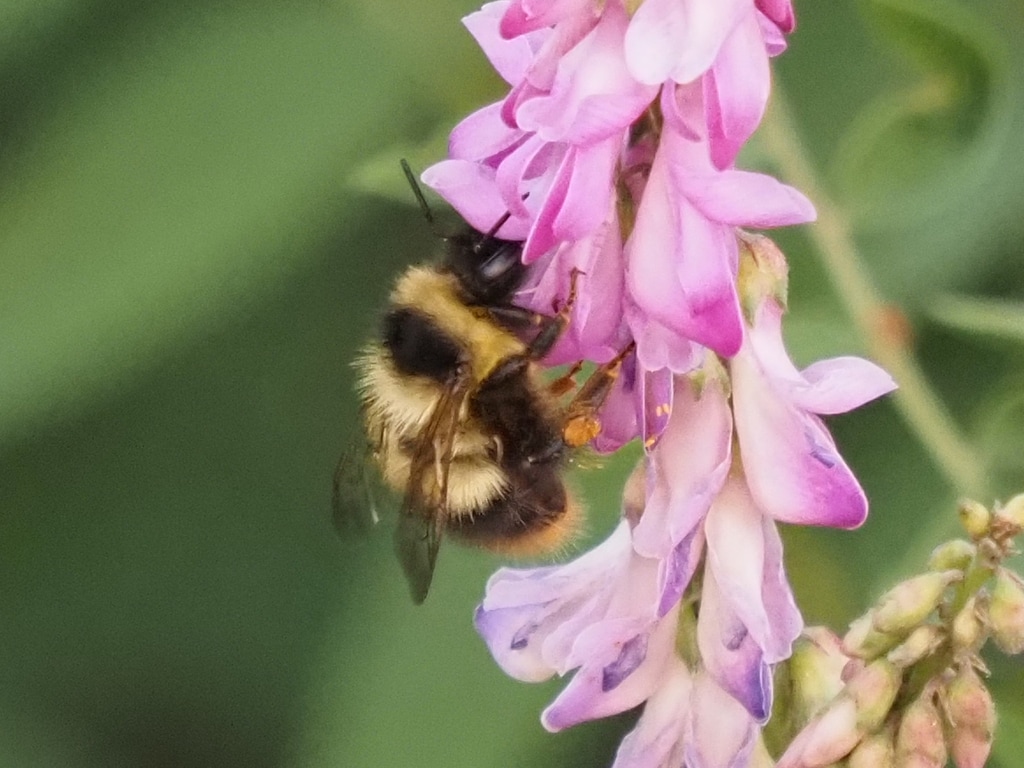
The frigid bumblebee (Bombus frigidus) is an uncommon bumblebee found in high-altitude environments. It mainly inhabits certain regions of the northwestern US.
These bumblebees usually have a black head with a yellow thorax. It has a black band between the wings. The upper segments of the abdomen are yellow, followed by a black segment. The last segment is usually orange.
Frigid bumblebees are medium-tongued bumbles that favor thistles, clovers, and blueberry flowers. As their name suggests, these bumblebees can withstand colder temperatures. Their range extends from Alaska south to Colorado and throughout Canada.
The frigid bumblebee lives in high mountain meadows, taiga, and arctic tundra habitats.
3. Fuzzy-horned Bumblebee

The fuzzy-horned bumblebee (Bombus mixtus) is found throughout western North America. Their range includes western Canada south to the western US. Another population can be found in the Great Lakes region of the Midwest.
Fuzzy-horned bumblebees live in open habitats, including grasslands, shrublands, and meadows. They can also be found in taiga and tundra habitats in the north.
Common flowers that you may spot these bumblebees on include fireweed and rhododendrons.
Most of the hair on the head and thorax is yellow. The abdomen is mainly black, and its tail end is orange.
4. Obscure Bumblebee

The obscure bumblebee (Bombus caliginosus) is a vulnerable species found in the northwestern US and parts of southern Canada. It’s also referred to as the fog-belt bumblebee. It inhabits shrublands and grasslands throughout its range.
Its head and thorax are mostly covered with yellow fur. Its abdomen is mainly black, with a yellow segment near its tail end.
According to the International Union for Conservation of Nature (IUCN), the obscure bumblebee population is decreasing. It’s possibly extinct in the eastern portions of its range in the northwestern US.
5. Brown-belted Bumblebee

Brown-belted bumblebees (Bombus griseocollis) are named for the reddish-brown segment some individuals have on the upper abdomen. This bumblebee species has a widespread distribution in the US, with a range extending from the West Coast to the East Coast.
Unlike many bumblebee species, the brown-bellied bumblebee population is stable. Its healthy population numbers are likely due to its adaptability to different kinds of habitats.
It successfully lives in open habitats such as meadows, farmlands, and wetlands. It’s also fairly common in urban areas where floral resources are abundant. It favors sunflowers, milkweed, and thistles.
6. Rusty-patched Bumblebee
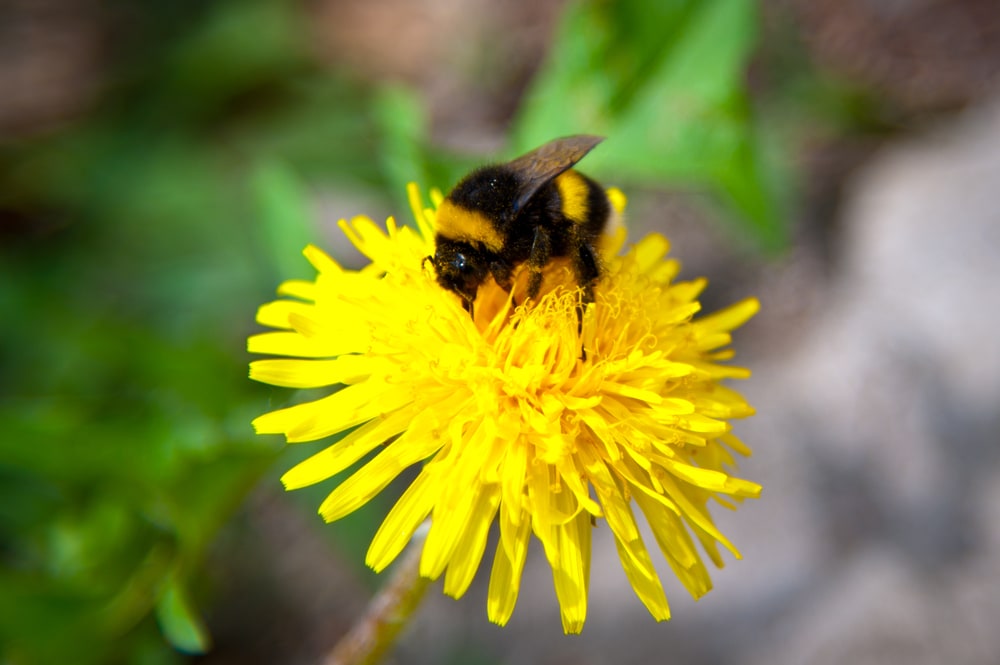
The rusty-patched bumblebee (Bombus affinis) is an endangered eastern US bumblebee species. It is one of two bumblebee species under federal protection under the Endangered Species Act (ESA).
Rusty-patched bumblebees were once abundant throughout their range, from the upper Midwest to the eastern US and southern Canada.
The exact reason for its rapid population decline is unknown. Evidence suggests that pathogens introduced by non-native bumblebees and the use of pesticides may play a significant role. A recovery plan was implemented in 2021 to help grow and maintain populations.
Rusty-patched bumblebees have large queens that can reach up to 2.3 cm (0.91 in) in length. Females and workers are much smaller, reaching up to 1.7 cm (0.67 in) in length.
7. Forest Bumblebee

The forest bumblebee (Bombus sylvestris) is a type of cuckoo bumblebee native to most regions in Europe and Russia. Cuckoo bumblebees are considered parasitic because they rely on other bumblebee species to survive.
Forest bumblebees are common parasites of early bumblebees.
Unlike most bumblebees, forest bumblebees don’t have pollen baskets. This means they can’t carry pollen to provide food for their offspring. Instead, they take over the colonies of other bumblebee species by getting rid of the queen and making the workers raise their young.
Forest bumblebees are fairly common and widespread throughout their range.
8. Red-belted Bumblebee

The red-belted bumblebee (Bombus rufocinctus) is a common species found throughout most parts of the US, except for the southeastern region.
These bumblebees can be hard to identify because they have more than 30 different color variations. They’re named for the orangish-red segment located on the abdomen.
Red-belted bumblebee queens emerge in April and live until September. Workers appear in June, and males appear in July. Some of their favorite flowers include goldenrods, thistles, and clovers.
9. Common Eastern Bumblebee

The common eastern bumblebee (Bombus impatiens) is found in the eastern half of the US. Their range extends from the northeastern US south to Florida and west to the Midwest. They can also be found in southeastern Canada.
As their name suggests, common eastern bumblebees are abundant throughout the eastern US. They’re often confused with eastern carpenter bees. You can distinguish the two by their appearance.
Carpenter bees aren’t as hairy as bumblebees. Carpenter bee abdomens are black, shiny, and lack hair. They’re also bigger than worker and male bumblebees.
Common eastern bumblebees nest underground in a variety of habitats. They can be found in farmlands and urban and suburban areas with floral resources. They also live in forests, grasslands, and marshes.
10. Two-spotted Bumblebee

The two-spotted bumblebee (Bombus bimaculatus) is native to the eastern half of the US and southeastern Canada. These bumblebees live in different habitats, depending on their range.
Two-spotted bumblebees found in the southeastern US mainly live in habitats in the Coastal Plain region. They can also be found in temperate and boreal forests and the eastern half of the Great Plains. They’re known to be common throughout their range.
These bumblebees mainly nest underground in burrows up to 12 inches (30 cm) deep. They prefer to collect pollen and nectar from Aquilegia flowers, which are common in woodlands and meadows.
11. Early Bumblebee

The early bumblebee (Bombus pratorum) is native to the US and parts of Asia and Europe.
The United Kingdom describes their most common bumblebee species as the “Big 7”. Early bumblebees are a part of this group due to their widespread range.
Early bumblebees are very common in woodlands and gardens. They’re known to visit more than 100 different flowering plant species and favor soft fruit plants. Rhododendrons are popular pit stops for queens.
One of the most distinct features of the early bumblebee is its reddish-orange tail. Some individuals have a black head, a yellow thorax, and a black abdomen with a yellow segment. Males may be more yellow compared to queens and workers.
12. Black and Gold Bumblebee
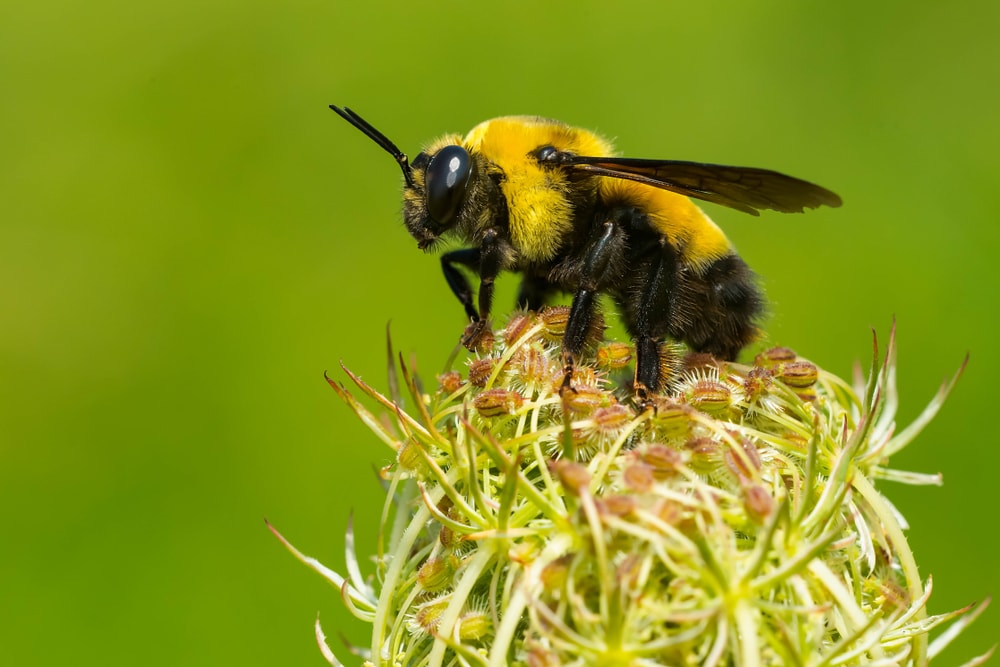
The black and gold bumblebee (Bombus auricomus) is one of the largest bumblebee species. Queens can reach up to 2.5 cm (0.98 in), while workers may reach up to 2 cm (0.79 in).
Black and gold bumblebees are most common in open-area habitats, such as grasslands and farmlands. They may appear in urban areas if floral resources are available.
They’re native to the eastern half of the US, from the Great Plains to the east coast. They can also be found in eastern Canada.
Some flowers that these bumblebees can be found on include thistles, bee balm, prairie clovers, and vetches. They typically build their nests above the ground. Their colonies are smaller than most, usually containing about 35 worker bees.
13. Arctic Bumblebee

The Arctic bumblebee (Bombus polaris) is an important pollinator in the harsh, cold climates of the North. They’re also called polar bumblebees. Their range includes Alaska and the northernmost portions of Canada, Scandinavia, and Russia.
These bumblebees are masters of keeping warm as they survive in their Arctic habitats.
Along with using their flight muscles to keep warm, they also rely on the sun and flowers. Cone-shaped flowers provide arctic bumblebees with warmth as the sunlight reflects on them.
Although all bumblebees are fuzzy, arctic bumblebees have extra hair to keep them warm. Some of their favorite flowers to visit are berry plants, such as lingonberry, bog blueberry, and alpine barberry.
14. Northern Amber Bumblebee

Northern amber bumblebees (Bombus borealis) are long-tongued bumblebees found in open habitats in North America. Their range encompasses the northern states of the US and Canada.
The first queens usually emerge in May, as temperatures in these northern regions begin to rise. Drones start to appear in July, about a month after workers do.
Northern amber bumblebees can be seen traveling from flower to flower in woodlands, prairies, and farmlands. They often visit wild blackberry flowers, milk vetches, goldenrods, and thistles.
15. Southern Plains Bumblebee
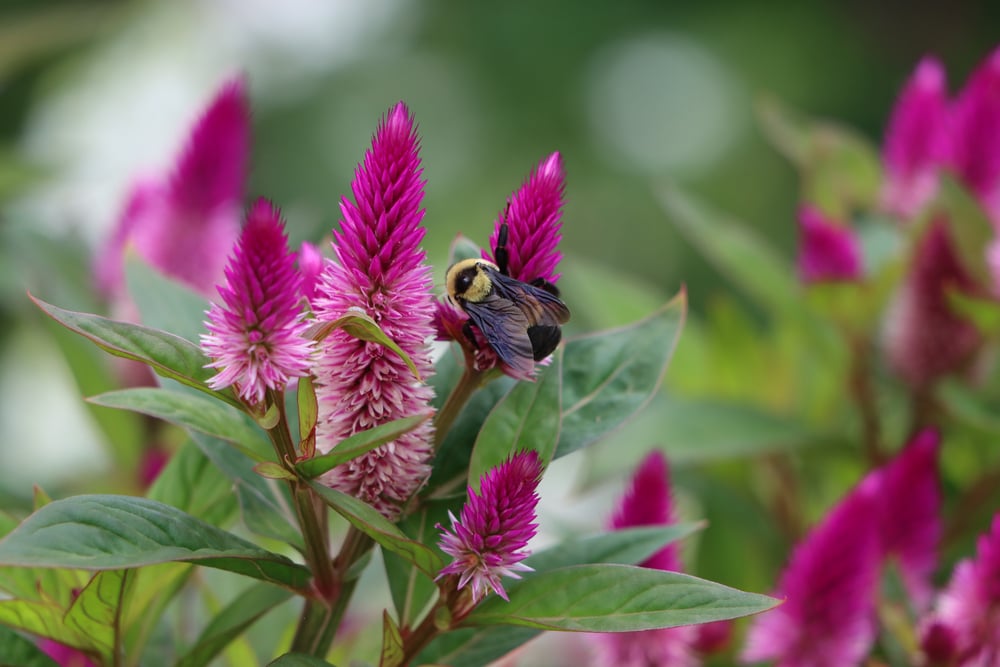
The southern plains bumblebee (Bombus fraternus) is an endangered bumblebee species found in the eastern half of the US. Its range extends east of the Rocky Mountains in the Midwest to the East Coast.
Populations are most abundant in the southern regions of the Great Plains and the southeastern US. It was once abundant in the central Great Plains, but populations have been decreasing. The IUCN last classified it as endangered in 2014.
Southern plains bumblebees live in a wide variety of open habitats, including open prairies and meadows.
16. Western Bumblebee

The western bumblebee (Bombus occidentalis) was once an abundant species found all across the western half of North America. Its historical range included the Pacific Coast, from Alaska and Canada south to New Mexico.
Western bumblebee populations have experienced a significant decline within the past few decades. Populations have been depleted along much of the Pacific Coast. Their current range in the US is now limited to the inner northwestern states.
Some of the most apparent threats to this species include pesticides, invasive species, and the spread of diseases.
17. Yellow Bumblebee

As the name suggests, the yellow bumblebee (Bombus fervidus) is almost completely covered in yellow hair. It has a thin black band between its wings and a black tail end.
The yellow bumblebee has a large range. Its range extends from Canada and the northern US south to Mexico. However, yellow bumblebees are most commonly found in the Northeast.
Nesting sites are established above and below ground. They’re built in close proximity to food sources. They live in open habitats, sometimes along roadsides.
Yellow bumblebees can fall prey to a number of predators, such as Chinese mantids, goldenrod spiders, and eastern moles.
18. Yellow-banded Bumblebee

Yellow-banded bumblebees (Bombus terricola) have historically been found in the northern US and Canada.
They’re now most abundant in the southern and western portions of their range due to various threats. It’s estimated that these bumblebees have lost more than one million square miles of their original range.
Yellow-banded bumblebees are short-tongued, meaning they can only feed on flowers with short corollas. Some flowers they frequent include sassafras, redbuds, and poplars.
Many bumblebees are less active during undesirable weather conditions. The yellow-banded bumblebee will forage for food rain or shine and during dawn or dusk.
19. Garden Bumblebe

The garden bumblebee (Bombus hortorum) is found in woodlands, gardens, and open habitats in low-lying areas of its range. It’s mainly found in the northeastern US. They’re also native to many parts of Europe, New Zealand, and some parts of Asia.
These bumblebees have long tongues and faces that allow them to reach into deep, cone-shaped flowers, such as foxgloves. Individuals can have a tongue that extends up to 2 cm (0.79 in) in length, which is about as long as their body!
20. Tree Bumblebee

The tree bumblebee (Bombus hypnorum) is native to parts of Europe and Asia. It can be found as far north as the Arctic Circle.
The species was first discovered in the United Kingdom in 2001, suggesting that its range is expanding. They have also been found in parts of Scotland.
Tree bumblebees are early spring emergers, first appearing in March. These species can be found along woodland edges and in urban areas with an abundance of flowers.
As their name suggests, tree bumblebees nest above ground in tree cavities. They’re also known to settle in other high areas, like bird boxes.
You may also like: More Than 16 Types Of Bees: A Field Guide to Everything About Bees
Where Do Bumblebees Live?

One of the reasons bumblebees are such effective pollinators is their adaptability to a wide range of habitats.
They can be found in most parts of the world, except Antarctica. Australia also doesn’t have any native bumblebee species. They’re most common in regions with temperate climates.
Bumblebees are cold-blooded insects, but some of their adaptations allow them to live in colder climates where other pollinators aren’t common.
Some bumblebees, such as the Arctic bumblebee, will rest on flowers to soak up the sun and get warm. Bumblebees are also able to stay warm by vibrating their flight muscles to generate heat. The hair on bumblebees is not only used to collect pollen but also to maintain body heat.
Most bumblebee species live in the northern hemisphere. Only a few bumblebee species are found south of the equator in places like South America. Bumblebees can only be found north of the Sahara Desert in Africa.

Some common habitats where bumblebees are found in the US include:
- Grasslands
- Farmlands
- Wetlands
- Woodlands and forest edges
- Urban and suburban areas with floral resources
The most important factor for bumblebee habitats is the abundance of flowering plants.
Bumblebees need nectar and pollen to survive. Worker bumblebees are constantly foraging for food for the entire colony. Larger colonies need more floral resources to help feed all of their members.
Colonies with around 100 bumblebees eat up to 2 grams (0.07 oz) of pollen every day. Areas with fewer floral resources may affect the size of a colony.
What Do Bumblebees Do?

Bumblebees are key pollinators of flowering plants, which is what they spend their entire lives doing. Worker bees are the primary pollinators in a bumblebee colony.
Queens will pollinate flowering plants as they collect food sources to prepare their nesting site.
However, worker bees take over once they become adults. Males don’t participate in foraging, so they don’t contribute to pollination as much as others in the colony.
Bumblebees have a special technique called buzz pollination. Bumblebees vibrate their flight muscles to dislodge pollen from plants. Buzz pollination is especially important for plants on which pollen is more difficult to dislodge from the anthers, such as tomato plants.

Most bumblebees are generalist foragers. This means that they aren’t too picky about what flowers they visit. This can be important for the reproduction of flowers that other pollinators may not visit often.
Bumblebees are not only important for the natural reproduction of plants, but they’re also used in commercial settings.
They’re used for commercial agriculture at farms and greenhouses. Although this helps with more efficient pollination, introducing non-native bumblebees to an area can be harmful to native bumblebees.
You may also like: 29 Types Of Butterflies: Your Field Guide To The World’s Flying Beauties
What’s the Difference Between a Honeybee vs Bumblebee?
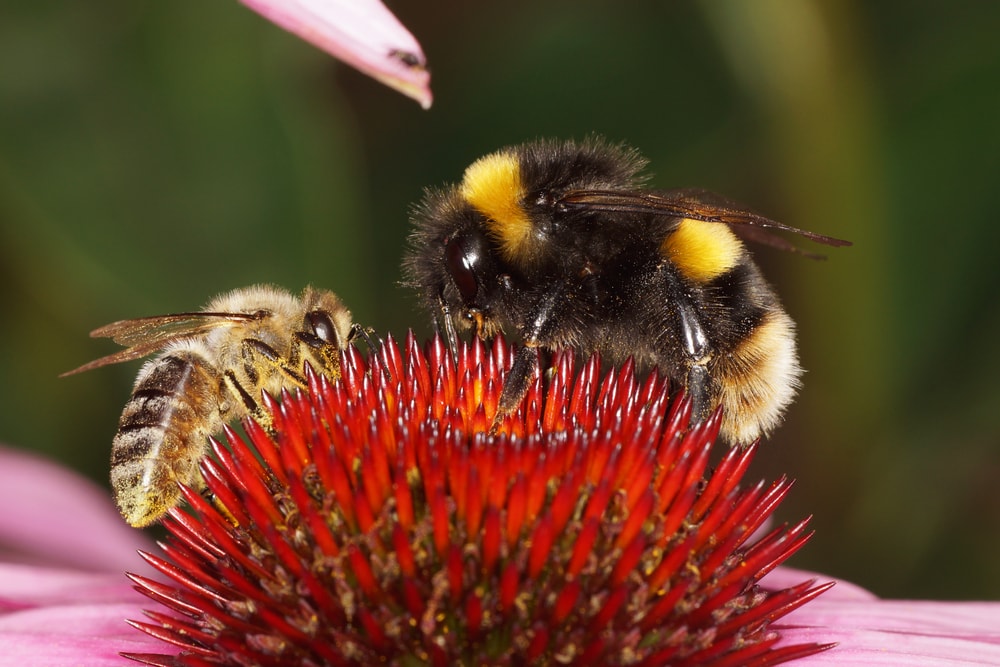
Honeybees and bumblebees are both members of the family Apidae. Honey bees belong to the genus Apis, while bumblebees belong to the genus Bombus.
Honeybees and bumblebees are both efficient pollinators. However, there are several differences between the honey bee vs bumblebee, such as:
Honey bees are known for their production of honey. Beekeepers often keep honey bees and harvest the honey for commercial purposes.
Bumblebees may be used commercially, but they’re better suited for pollination than honey production.
Honey bees are less hairy than bumblebees. Honey bees are also smaller and have a more slender body.

The tongue length of bumblebees can vary from short to medium to long. This allows them to visit a wider range of flowers with shallow or deep corollas. Honey bees usually only visit flowers with short corollas because they have short tongues.
Bumblebee colonies are fairly small compared to honey bee colonies. Bumblebee colonies may grow to about 2,000 individuals.
However, there are smaller colonies with fewer than 50 individuals. Honey bees have large colonies with thousands to tens of thousands of individuals.
Do Bumblebees Make Honey?

Bumblebees are capable of making honey from the nectar they supply in the nest. However, bumblebees don’t produce nearly as much honey as honey bees.
Bumblebees are seasonal creatures that are most active during the spring and summer. By the fall, most bumblebees in the colony had died.
Only the drones and new queen bees are left to mate. Males die after mating, and new queens search for a hibernation site to go dormant in the winter.
Honey bees stay active year-round. However, you may not see them in the late fall or winter because they’re in the hive.
Honey bees produce large amounts of honey to maintain a healthy food supply for overwintering. Since there aren’t many food resources to collect during the winter, honey bees rely on their abundance of honey to survive.
What’s the Difference Between a Carpenter Bee vs Bumblebee

Carpenter bees are often easily confused with bumblebees because of their similar appearance. However, carpenter bees have a shiny abdomen and don’t have as much hair.
Carpenter bees are often seen hovering in the air. Bumblebees don’t spend a lot of time hovering. They’re usually seen on flowers or traveling from flower to flower to forage for food.
Carpenter bees are nicknamed boring bees because they bore into wood. Carpenter bees are usually seen as pests by homeowners because they can damage wooden structures with their boring habits.
You may also like: What Do Bees Eat? All About the Rich Diet of a Bee
How to Identify Bumblebee Species

It can be difficult to identify many bumblebee species. One of the most visible and distinguishable characteristics between bumblebee species is color and size. Some bumblebees are much smaller than others.
The hair color and pattern of bumblebees can help you identify different species. There are three main parts to the insect body: the head, thorax, and abdomen.
Bumblebees have 6-7 abdominal segments called tergites. These segments are often covered with different-colored hairs that can help you identify a specific species.
Some bumblebees have a mostly yellow thorax, while others may have a mostly black thorax. Certain tergites may be yellow, black, or reddish-orange. Some bumblebees have a black tail end, while others may have a yellow or white tail end.
On a larger scale, you may be able to narrow down your bumblebee identification by knowing what bumblebees are native to your area. Some bumblebees in the US are only found in the west, while others can only be found in the east.
You may also like: How Long Do Bees Live? Everything You Need to Know About the Life of a Bee
Bumblebees Fun Facts

Bumblebees are one of the few types of social bees.

Most types of bees are solitary and don’t live in large colonies. Some examples of solitary bees include sweat bees, digger bees, and mason bees.
Bumblebees and honeybees are two bee groups known to be eusocial. This means they have a complex social organization system.
Bumblebees may live in colonies ranging from less than 50 individuals up to 2,000 individuals. Queens are responsible for founding the colony.
Once the first brood of worker bees becomes adults, they take over brood care and foraging. Males and new queens are the last to be born in the bumblebee’s life cycle. Their main purpose is to reproduce. The following spring, new queens found the next generation.

Worker bees cannot reproduce.

Worker bees are female bees, but they can’t reproduce. Queen bumblebees are capable of managing the sex of the eggs. They do this by laying fertilized and unfertilized eggs. Fertilized eggs hatch as females. Queen bumblebees produce males by laying unfertilized eggs.
Honey bees make queens by feeding larvae royal jelly. Royal jelly is a special mixture of nutrients that helps larvae grow into queens. Bumblebees don’t produce royal jelly. Instead, they’re fed more food compared to other workers to become queens.
Only queen bumblebees and drones are responsible for reproduction.

Bumblebees need to be at a specific temperature to fly.

Bumblebees are capable of thriving in colder climates despite being cold-blooded. They use their flight muscles or bask in the sun to heat up their bodies. This process is called thermoregulation.
In order to fly, bumblebees need to have an internal temperature of at least 86°F (30°C). Arctic bumblebees are capable of heating their internal body temperature up to 60°F (15.5°C) higher than the surrounding air temperature.
You may also like: Types of Stink Bugs: Field Guide (Names & Photos)
Bumblebee FAQs

Where do bumblebees nest?
Bumblebees can live in nests above or below ground, depending on the species. Some species participate in both forms of nesting. Many bumblebee species favor underground nesting.
Bumblebees don’t usually excavate their own nests. They find small abandoned burrows, usually created by a rodent, to nest in. Some bumblebees may create nests on the ground under debris. Bumblebee nests look like a conglomeration of small pots.
Are bumblebees endangered?
There are two bumblebee species listed as endangered under the ESA. These species include the rusty-patched bumblebee and Franklin’s bumblebee.
The Franklin’s bumblebee is one of the most endangered bumblebee species in the world. The IUCN has listed it as critically endangered. Their staggeringly low population numbers make them very difficult to monitor and observe.
How long do bumblebees live?
Bumblebee lifespans range from about one month to a year. Queen bumblebees typically live for one year. They emerge in the late fall, find a new colony in the spring, and die in the late fall.
Worker bees may live for a few weeks to a few months, beginning in the spring or fall. Males have the shortest lifespan, as they emerge in the middle of summer and die by late fall.
What flowers do bumblebees like?
If you’re interested in attracting bumblebees to your yard, you can do so by providing an abundance of native floral resources. Since bumblebees are generalists, they will visit a wide variety of flowering plants.
Different bumblebees may favor different types of flowering plants native to their range. So the types of flowers bumblebees favor can depend on where you live.
Some common flowers that bumblebees tend to visit include flowers in the nightshade family, clovers, thistles, goldenrods, and honeysuckle.
It’s important to plant native plants in your garden to promote a healthy environment for native bees, insects, and other animals.
Can bumblebees sting?
Yes, bumblebees do have stingers. Only female bumblebees are capable of stinging. Males don’t have a stinger.
Bumblebees are considered fairly docile unless they’re disturbed.
If they’re provoked or their nest feels a vibration, they may attempt to sting the threat.
Honeybees have barbed stingers, but bumblebee stingers are smooth. Since honeybees have barbed stingers, their stingers get ripped out when they sting something. This means that they can die shortly after stinging.
Since bumblebees have a smooth stinger, it doesn’t get ripped out upon stinging. Bumblebees can sting an animal or person multiple times without dying.









